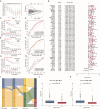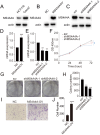A novel risk stratification approach and molecular subgroup characterization based on coagulation related genes in colon adenocarcinoma
- PMID: 39252019
- PMCID: PMC11386116
- DOI: 10.1186/s12935-024-03491-2
A novel risk stratification approach and molecular subgroup characterization based on coagulation related genes in colon adenocarcinoma
Abstract
Colon adenocarcinoma (COAD) represents a significant health concern within the population. Advancing our understanding of COAD is imperative for early detection, enabling personalized treatment interventions, and facilitating the development of effective preventive measures. The coagulation system plays a role in tumor-related pathological processes; however, its specific involvement in COAD and potential contributors remain unclear. This study aimed to establish a novel risk stratification approach by analyzing coagulation related genes (CRGs) associated with COAD. Through a comprehensive bioinformatics analysis of data from public databases, we screened COAD associated CRGs and characterized the associated molecular subtypes. After a comprehensive analysis of the characteristics of each subtype, we applied differentially expressed genes in CRG subtypes to establish a new risk stratification method. Clinical subgroup analysis, immunoinfiltration analysis, therapeutic reactivity prediction and other analytical methods suggest the potential clinical value of the established risk stratification method. As one of the selected targets, the effect of MS4A4A on the proliferation and invasion of COAD was confirmed by in vitro experiments, which partially verified the reliability of bioinformatics results. Our findings delineate CRGs potentially implicated in COAD pathogenesis and offer fresh insights into the influence of the coagulation process on tumorigenesis and progression.
Keywords: Coagulation related genes; Colon adenocarcinoma; Immune infiltration; MS4A4A; Risk stratification.
© 2024. The Author(s).
Conflict of interest statement
The authors declare no competing interests.
The authors declare that the research was conducted in the absence of any commercial or financial relationships that could be construed as a potential conflict of interest.
Figures









Similar articles
-
Development of a Mitochondrial Membrane Permeability Transition Prognosis System in Colon Adenocarcinoma: Risk Stratification and Therapeutic Target Identification.Curr Med Chem. 2024 Oct 7. doi: 10.2174/0109298673335900240920070746. Online ahead of print. Curr Med Chem. 2024. PMID: 39377410
-
Cuproptosis-related risk score predicts prognosis and characterizes the tumor microenvironment in colon adenocarcinoma.Front Oncol. 2023 Jun 2;13:1152681. doi: 10.3389/fonc.2023.1152681. eCollection 2023. Front Oncol. 2023. PMID: 37333810 Free PMC article.
-
Characterization of mitochondrial metabolism related molecular subtypes and immune infiltration in colorectal adenocarcinoma.Sci Rep. 2024 Oct 17;14(1):24326. doi: 10.1038/s41598-024-75482-2. Sci Rep. 2024. PMID: 39414905 Free PMC article.
-
Investigating gene signatures associated with immunity in colon adenocarcinoma to predict the immunotherapy effectiveness using NFM and WGCNA algorithms.Aging (Albany NY). 2024 May 13;16(9):7596-7621. doi: 10.18632/aging.205763. Epub 2024 May 13. Aging (Albany NY). 2024. PMID: 38742936 Free PMC article.
-
Molecular Subtypes Based on Mitochondrial Oxidative Stress-related Gene Signature and Tumor Microenvironment Infiltration Characterization of Colon Adenocarcinoma.Curr Med Chem. 2024 Sep 5. doi: 10.2174/0109298673318692240829053543. Online ahead of print. Curr Med Chem. 2024. PMID: 39238391
References
-
- Brivio F, Fumagalli L, Fattori L, Nespoli L, Denova M, Sargenti E, Nespoli A. [Clinical role of interleukin-2 in the surgical treatment of liver metastasis due to colon adenocarcinoma]. Minerva Chir. 2004;59(6):573–82. - PubMed
-
- Brzozowa-Zasada M, Matysiak N, Piecuch A, Gawelek E, Michalski M, Kucharzewski M, Los MJ. The Prognostic significance of apoptotic protease activating factor (Apaf-1) protein expression in Colon adenocarcinoma tissue-preliminary Report. Front Biosci (Landmark Ed). 2023;28(2):29. 10.31083/j.fbl2802029 - DOI - PubMed
LinkOut - more resources
Full Text Sources
Research Materials

